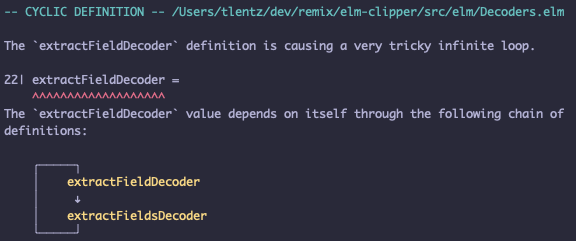From Elm Slack
For example:
type ExtractFields
= List ExtractField
type alias ExtractField =
{ name : String
, selector : Selector
, extractType : Maybe ExtractType
, extractFields : ExtractFields
}
extractFieldsDecoder : Decoder ExtractFields
extractFieldsDecoder =
extractFieldDecoder
|> Decode.list
extractFieldDecoder : Decoder ExtractField
extractFieldDecoder =
Decode.map4 ExtractField
nameDecoder
selectorDecoder
extractTypeDecoder
(field "extract_fields" extractFieldsDecoder)This gives the following error:
You need the following function:
Json.Decode.lazy- in elm/json
The following were removed in 0.19:
uncurry
curry
flip
These can now be found in the following package:
Basics.Extra- elm-community/basics-extra
type alias Model =
{ name : String
, password : String
, passwordAgain : String
}The main benefit of using a type alias for this is when we write the type annotations for the update and view functions. Writing Msg -> Model -> Model is so much nicer than the fully expanded version! It has the added benefit that we can add fields to our model without needing to change any type annotations.
When you create a type alias specifically for a record, it also generates a record constructor. So if we define a User type alias, we can start building records like this:
> type alias User = { name : String, age : Int }
> User
<function> : String -> Int -> User
> User "Sue" 58
{ name = "Sue", age = 58 } : User
> User "Tom" 31
{ name = "Tom", age = 31 } : UserThis is only for records. Making type aliases for other types will not result in a constructor.
- Subscriptions & Commands - A bit like Haskell's IO monad: can get impure stuff from the runtime system like the current time and issue commands to the runtime system that produce side-effects
Result- Elm's name for the HaskellEithertype
elm-ui is mentioned in this talk as a "potential killer app of Elm". Worth looking into.
In JavaScript, the approach is to just turn JSON into JavaScript objects and hope nothing goes wrong. But if there is some typo or unexpected data, you get a runtime exception somewhere in your code. Was the code wrong? Was the data wrong? It is time to start digging around to find out!
In Elm, we validate the JSON before it comes into our program. So if the data has an unexpected structure, we learn about it immediately. There is no way for bad data to sneak through and cause a runtime exception three files over. This is accomplished with JSON decoders.
Use NoRedInk/elm-json-decode-pipeline to avoid all the tedious mucking about with map2 etc.
Note how map2 is implemented separately for JSON.Decode and List since there's no polymorphic instances for tuples/lists/whatever for something like fmap, and no way to get multiple monadic values with a do notation and return the tuple.
